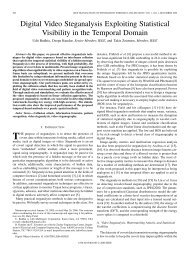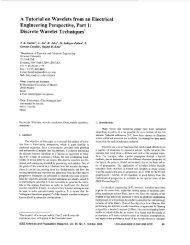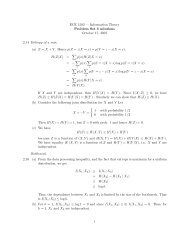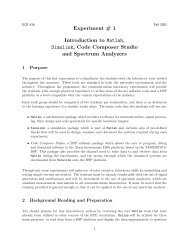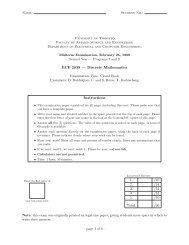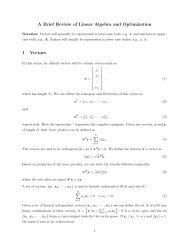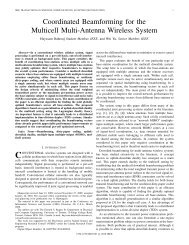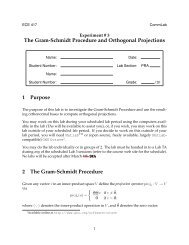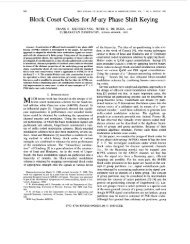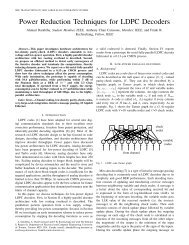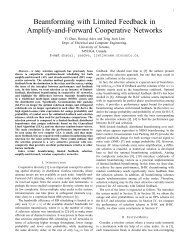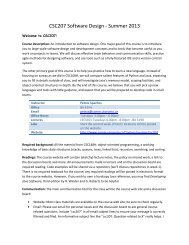On the use of cyber-physical hierarchy for - IEEE Xplore
On the use of cyber-physical hierarchy for - IEEE Xplore
On the use of cyber-physical hierarchy for - IEEE Xplore
Create successful ePaper yourself
Turn your PDF publications into a flip-book with our unique Google optimized e-Paper software.
1<br />
G 1<br />
Agent 1 Agent 2<br />
Agent 1 Agent 2<br />
G 2<br />
12 13<br />
G 1<br />
G 3<br />
G 1<br />
2 23<br />
3<br />
G 2 G 3<br />
G 2<br />
G 3<br />
(a)<br />
(b)<br />
(c)<br />
(d)<br />
Fig. 2. WECC 9-bus power system representations. Solid (dashed) lines represent <strong>physical</strong> (<strong>cyber</strong>) couplings. (a) Dynamical-graph representation<br />
<strong>of</strong> Kron-reduced system, (b) Cyber-<strong>physical</strong> couplings without <strong>hierarchy</strong>, (c) Hierarchical <strong>cyber</strong>-<strong>physical</strong> couplings <strong>for</strong> 3-phase short<br />
at Bus 6, (d) Possible two-tier <strong>hierarchy</strong>.<br />
Normalized Frequency<br />
1.8<br />
1.7<br />
1.6<br />
1.5<br />
1.4<br />
1.3<br />
1.2<br />
1.1<br />
G1<br />
G2<br />
G3<br />
1<br />
0 2 4 6 8 10<br />
Time (s)<br />
(a) Normalized frequencies versus time.<br />
Phase Angle (Degree)<br />
104 G1<br />
8<br />
G2<br />
G3<br />
6<br />
4<br />
2<br />
0<br />
−2<br />
0 2 4 6 8 10<br />
10 x Time (s)<br />
(b) Phase angles versus time.<br />
Phase Angle Difference (Degree)<br />
104 G1 and G2<br />
6 G1 and G3<br />
G2 and G3<br />
4<br />
2<br />
0<br />
−2<br />
−4<br />
−6<br />
−8<br />
0 2 4 6 8 10<br />
8 x Time (s)<br />
(c) Phase angle differences versus time.<br />
Fig. 3. Results <strong>for</strong> 3-phase short at Bus 6 when line is removed at t =0.3 s without application <strong>of</strong> flocking-based control; G 1 and G 2 <strong>for</strong>m<br />
a coherent group distinct from G 3.<br />
value is unity not zero as <strong>for</strong> <strong>the</strong> relative normalized frequency ω ∗ )<br />
and phase when <strong>the</strong> two-tier flocking-based <strong>cyber</strong>-<strong>physical</strong> control<br />
is activated at t =0.45 s. The injected power is shown in Fig. 6(a)<br />
and demonstrates clipping <strong>for</strong> G 1 and G 3; <strong>the</strong> injected power at bus<br />
G 2 is zero given <strong>the</strong> tiered architecture and its <strong>physical</strong> coherence to<br />
G 1.<br />
In contrast, Fig. 2(b) illustrates <strong>the</strong> flocking-based <strong>cyber</strong>-<strong>physical</strong><br />
control framework without <strong>the</strong> <strong>hierarchy</strong> [1]. All generators have<br />
<strong>the</strong> same priority and <strong>the</strong> <strong>cyber</strong> links exist connecting each generator<br />
pair; this full connectivity comes at <strong>the</strong> cost <strong>of</strong> communication<br />
overhead. Figure 6(b) shows <strong>the</strong> associated P u,i with clipping as<br />
discussed above. Thus, every generator pair is coupled through both<br />
<strong>cyber</strong> and <strong>physical</strong> means. This is in contrast to Fig. 2(c) in which<br />
all generators are coupled <strong>physical</strong>ly, but <strong>cyber</strong> coupling only exists<br />
between G 1 and G 3. Assuming that <strong>the</strong> control is activated at<br />
t = 0.4 s, Fig. 5 presents <strong>the</strong> results. Comparing Figs. 4 and 5<br />
we observe that our two-tier framework does not ca<strong>use</strong> noticeable<br />
reduction in maintenance <strong>of</strong> transient stability.<br />
Figure 6(c) compares <strong>the</strong> total power transmission between <strong>the</strong><br />
fast-reacting power grid and <strong>the</strong> WECC 9-bus power system by using<br />
<strong>the</strong> <strong>cyber</strong>-<strong>physical</strong> control framework with and without <strong>the</strong> two-tier<br />
hierarchical structure. The area under each power transmission curve<br />
determines <strong>the</strong> total energy exchanged between <strong>the</strong> fast acting grid<br />
and <strong>the</strong> WECC 9-bus system to enable transient stability in <strong>the</strong> face<br />
<strong>of</strong> <strong>the</strong> fault. Thus, <strong>the</strong> results validate <strong>the</strong> energy efficiency <strong>of</strong> our<br />
proposed two-tier hierarchical control framework.<br />
In order to evaluate <strong>the</strong> robustness <strong>of</strong> our approach to delays<br />
in <strong>cyber</strong> in<strong>for</strong>mation possibly stemming from denial-<strong>of</strong>-service <strong>cyber</strong><br />
attacks, we study <strong>the</strong> per<strong>for</strong>mance <strong>of</strong> our control strategy in <strong>the</strong><br />
face <strong>of</strong> in<strong>for</strong>mation delay. Figs. 7 and 8 evaluate <strong>the</strong> per<strong>for</strong>mances <strong>of</strong><br />
our hierarchical and non-hierarchical control strategies, respectively,<br />
under a communication delay <strong>of</strong> τ =0.05 s; here, <strong>the</strong> in<strong>for</strong>mation<br />
from neighboring generators <strong>use</strong>d <strong>for</strong> computation <strong>of</strong> u i is assumed<br />
to be delayed by τ. We observe that our hierarchical structure is<br />
more robust to communication delay as transient stability is facilitated<br />
whereas <strong>for</strong> <strong>the</strong> non-hierarchical case instability results. We<br />
believe that <strong>the</strong> reason <strong>for</strong> this stems from <strong>the</strong> greater dependence on<br />
<strong>physical</strong> couplings within <strong>the</strong> hierarchical approach which makes <strong>the</strong><br />
approach less susceptible to <strong>cyber</strong> attacks applied to <strong>the</strong> in<strong>for</strong>mation<br />
<strong>use</strong>d to compute <strong>the</strong> control laws.<br />
We emphasize that our two-tier approach requires that generator<br />
groupings within agents must exhibit <strong>physical</strong> coherence <strong>for</strong> correct<br />
identification <strong>of</strong> lead generators. For example, if <strong>for</strong> <strong>the</strong> case <strong>of</strong> <strong>the</strong><br />
3-phase short circuit at Bus 6 <strong>the</strong> generator groupings do not follow<br />
<strong>the</strong> results <strong>of</strong> <strong>the</strong> coherence identification method but instead <strong>the</strong> lead<br />
generators are selected to be G 1 and G 2 <strong>the</strong> hierarchical flockingbased<br />
control does not enable transient stability.<br />
5. FINAL REMARKS<br />
Overall, we have investigated <strong>the</strong> application <strong>of</strong> <strong>hierarchy</strong> <strong>for</strong> <strong>cyber</strong><strong>physical</strong><br />
control and security <strong>of</strong> smart grid systems. The generators<br />
within a smart grid are grouped into coherent clusters such that<br />
each cluster is embodied by an agent. The first layer in <strong>the</strong> two-tier<br />
framework reflects <strong>cyber</strong>-<strong>physical</strong> interactions amongst lead genera-



